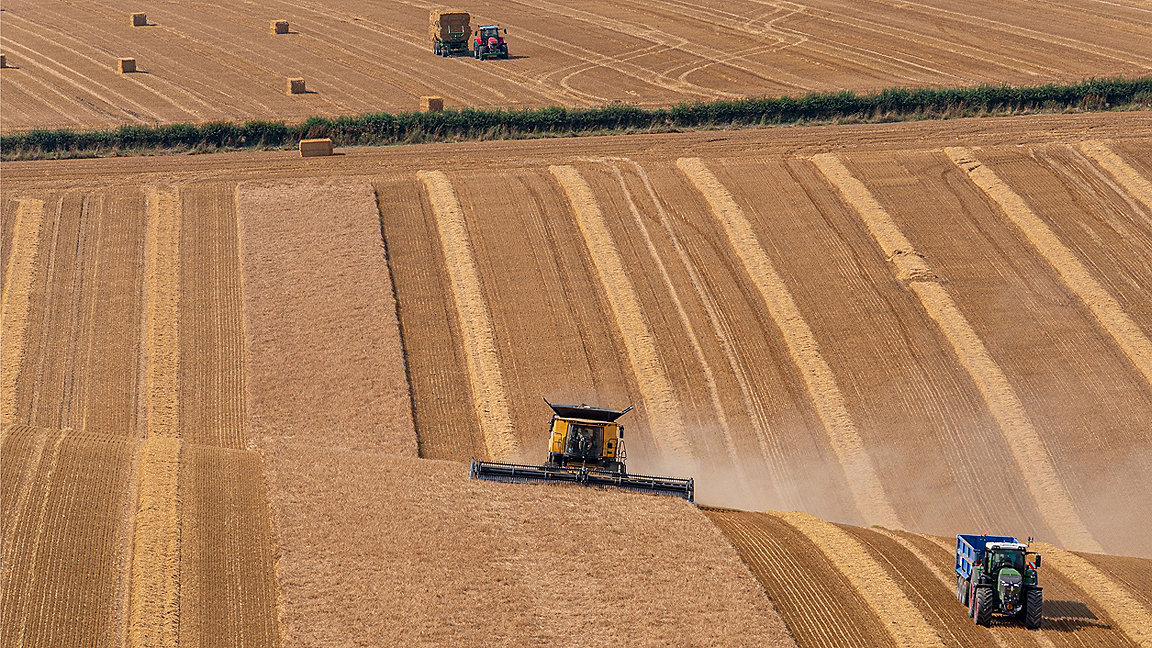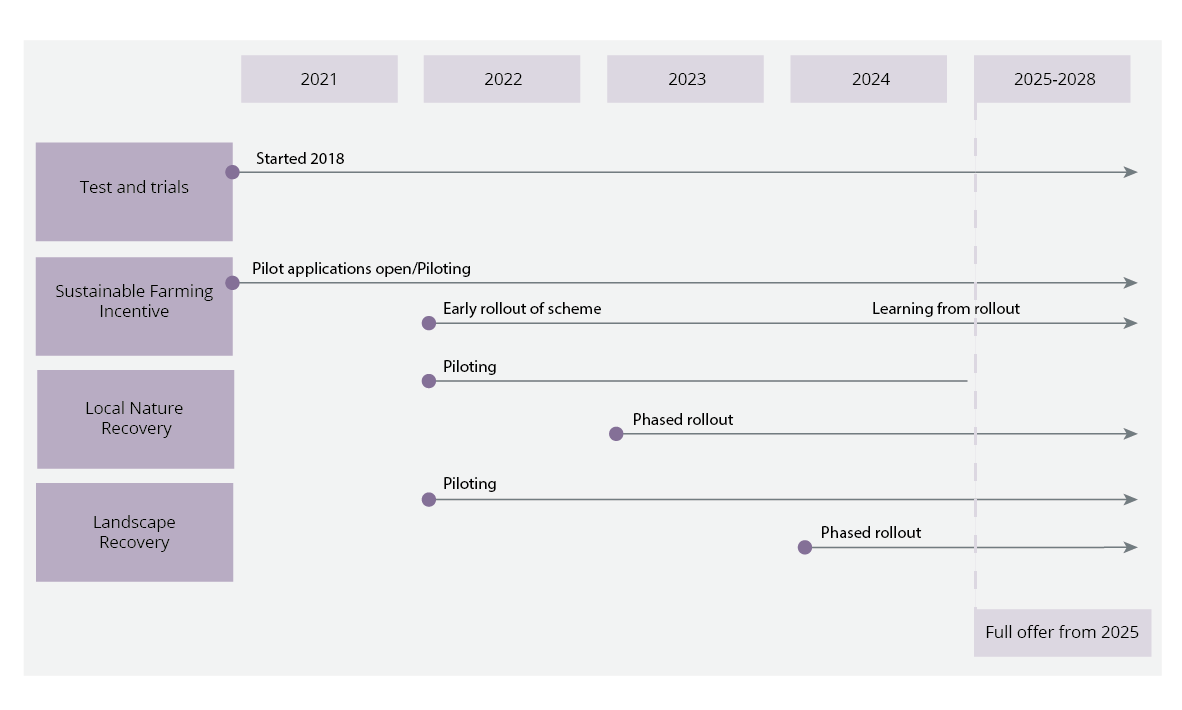
Defra is designing its three new environmental land management schemes in partnership with the people who will use them, to ensure the schemes work for them, as well as achieving the government's environmental goals.
Our aim is for farming and the countryside to support environmental, biodiversity and climate change targets by protecting and enhancing the natural environment. And our future policy will help farmers continue to provide a supply of healthy, home-grown produce to high environmental and animal welfare standards. We know that productivity and farming sustainably go hand in hand.
To achieve this, we are making changes including phasing out direct payments. We will maintain current average levels of investment in farming of £2.4bn per year in England over the life of this Parliament. All funding released from reductions in direct payments will be reinvested into new schemes, primarily ones that provide environmental and climate outcomes.
There will be an evolution from the old system to the new, not an overnight revolution. We will learn from new approaches and evolve parts of our policy framework – improving and developing over time. The changes will happen over a seven-year agricultural transition period, from 2021 to 2027, giving farmers and land managers time to prepare and adapt.
Introducing the environmental land management schemes
Farmers and land managers are not always properly rewarded for their contribution to our environment. The actions they take now can help to preserve our natural landscapes and natural capital for future generations – something that benefits us all. We believe the protection and enhancement of our environment should be considered the preeminent public good, providing value for farmers, land managers, the public and taxpayers.
Our new environmental land management schemes will reward farmers and land managers for providing public goods and they will help to achieve many of the aims of the UK government's 25-year environment plan.
These are the environmental public goods we've identified for these schemes.
-
clean and plentiful water
-
clean air
-
reduction in and protection from environmental hazards
-
mitigation of and adaptation to climate change
-
thriving plants and wildlife
-
beauty, heritage and engagement with the environment.
The three environmental land management schemes are:
-
The Sustainable Farming Incentive, which launches in 2022. Designed for farmers, it will pay for actions that generate significant environmental benefits, and animal health and welfare outcomes.. It will accelerate the large-scale adoption of more sustainable approaches on all types of farms, building on the excellent practices that are already happening. We're designing the scheme to be accessible, relevant, and attractive to the widest possible range of farmers – to support at least 70% of eligible farms to take part by 2028.
-
Local Nature Recovery. Phased rollout starts from 2023 and will pay for actions that will achieve our environmental priorities in a locally targeted way.
-
The Landscape Recovery scheme will begin piloting in 2022. It will support long-term, large-scale, land-use change and habitat restoration projects.
The way we pay for public goods will be different – with less prescription, more choice and flexibility. The length of the agreements will be flexible according to what farmers and land managers want to provide through their agreements. There is more detail on the future schemes and other policy changes in our Agricultural Transition Plan published in November 2020, as well as in the June 2021 update.
We published more information on the Sustainable Farming Incentive on 2 December 2021. This document builds on the information in the November 2020 Agricultural Transition Plan – which also includes detail on other schemes and the June 2021 update.
Timings
Figure 1 shows you how the schemes fit together. We've been carrying out tests and trials on the schemes since 2018, and these will continue throughout the transition period to the end of 2027.
The first Sustainable Farming Incentive pilot agreements started in November 2021, with farmers across England helping us to develop and test parts of the scheme before they're added to the live service. Next year we will start to roll out core elements of the scheme – expanding them until the full offer is available from 2025.
To give farmers flexibility, we are running Countryside Stewardship and the Sustainable Farming Incentive in parallel. You can be in both at the same time and can apply for new Countryside Stewardship agreements until February 2023, with the last agreements starting on 1 January 2024 – after that, the full offer for the three environmental land management schemes will be available. We plan to start a phased rollout of Local Nature Recovery from 2023.
We'll launch at least 10 Landscape Recovery pilot projects between 2022 and 2024, to provide more than 20,000ha of wildlife-rich habitat. We will publish more information on Local Nature Recovery and Landscape Recovery next year.

Focus on the Sustainable Farming Incentive
The Sustainable Farming Incentive is the first of our new schemes to launch. In 2022, we will start to roll out core elements of the scheme, expanding them until we have the full offer available from 2025. By rolling out the new scheme in an incremental way, we can expand and improve it as we go – learning from our pilot.
The core elements of the Sustainable Farming Incentive that will be available in 2022 are the:
-
arable and horticultural soils standard
-
improved grassland soils standard
-
moorland and rough grazing standard
-
annual health and welfare review.
There is more detail on these elements in Sustainable Farming Incentive: how the scheme will work in 2022, published 2 December 2021.
Who is eligible?
When the Sustainable Farming Incentive launches in 2022, the environmental standards will be open to farmers who are eligible for payments under the Basic Payment Scheme (BPS). The Annual Health and Welfare Review will initially be available for all commercial cattle, pig and sheep keepers who are eligible for BPS.
Farmers in existing agri-environment schemes will be eligible too, and you can participate in more than one environmental land management scheme – once they’re all available – but we will not pay someone twice for the same activity, and you can’t carry out contradictory actions on the same area of land.
Over time, we plan to extend the scheme to a broader range of farmers. We will test and develop how to do this through the scheme pilot and our ongoing tests and trials.
Get involved
We developed the Sustainable Farming Incentive scheme and its standards with input from a range of farmers and other experts.
We are grateful to everyone who has worked with us so far for their time and commitment. Your involvement will ensure our schemes work in practice, and achieve our environmental and climate change goals. We plan to continue our engagement this year. Please email the co-design team if you are interested in working with us.
